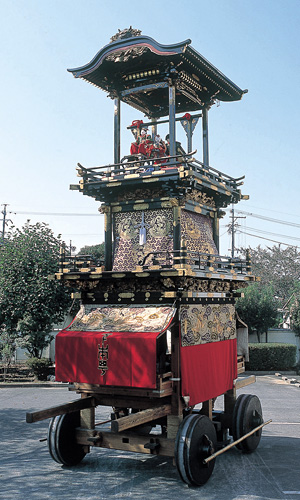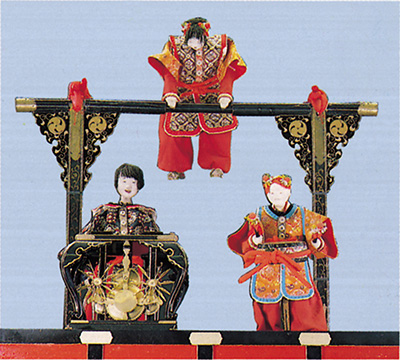 車山とからくり
車山とからくり
下本町の車山

◆應合子(おうごうし)
一六三五年に魚屋町とともに馬の塔や聖の練り物を出して、犬山祭の礎を作った町内。唯一、屋根に梵天を付けていないことが特徴の車山で、豪華な装飾と凝った彫り物が見物である。からくりは、名古屋の文吉離三が制作したもので、唐子のダイナミックな大車輪が見られる高度な「離れからくり」。本楽でこのからくり奉納を終えると、たとえ降雨でも祭礼が成立することとなっている。
◆Ogoshi Yama (Shimohonmachi Precinct)
Shimohonnmachi, with its ceremonially decorated horse (Umanoto), joined the festival procession in 1635 as did Uoyacho Pricienct. They are the oldest participants of this procession. A distinguishing feature of this yama is the absence of a bonten on its roof. The bonten is a shinto ritual staff with streamers of white ceremonial paper attached. This yama features elaborate tapestry and carvings. The karakuri is hanare karakuri type. A puppet makes an acrobatic swing by itself. Once this yama offers its performance at the Haritsuna Shrine, the festival is said to be official even if scheduled events to follow are cancelled by inclement weather.
下本町のからくり人形

◆應合子(おうごうし)
寛永12年(1635)魚屋町と下本町が馬の塔と練り物を出したのが犬山祭の始まりとされている。からくりも当町の新三が作った「蜘舞」という青竹に人形を付けて、ぐるぐる廻す単純なものだったようです。安永4年(1775)には唐子の大人形が小人形を肩にのせるからくりが名古屋の文吉離三によって制作され、今日の車山とからくりの原型が成立したと考えられる。車山名の「應合子」は、2体の唐子人形が合体したり、離れたりするからくりの技に由来しています。唐子人形3体で展開されるからくりは、楽の音に合わせて、蓮台の上に居る中人形が立ち上がり、それに向かって大人形が進み出て、中人形を肩車に乗せ、舞竹の所まで行き、それにつかまらせて下がります。そして、中人形が舞竹につかまり2回転すると、再び大人形が現れて、中人形を肩車に乗せ、もとの蓮台の上に戻します。その間小人形はその様子を見ながら、小太鼓を打って応援しています。中人形の舞竹での回転と、大人形と中人形の合体や、離れ技が見所です。
◆Ogoshi (Combination and separation)
The origin of the Inuyama Festival dates back to 1635 when Uoyacho Precinct and Shimohonmachi Precinct paraded decorated horses down the street.
The karakuri mechanisms at that time, called Kumomai, were quite simple. They were simply puppets swinging around and around on bamboo poll. In 1775 a mechanic in Nagoya created the karakuri doll as used today. The original karakuri doll in current form was a small doll riding on the shoulder of a bigger doll.
The floats name, Ogoshi Yama, comes from the movement of the dolls both in tandem and in their separation as they constantly separate and are brought back together. Three karakuri participate in the performance. With musical accompaniment the smallest karako stands up on a pedestal. A larger karako comes and put the smaller karako on his shoulders. The smaller karako reaches up and seizes a bar. It then does two giant swings before coming back and standing on the larger karako’s shoulder again. The larger karako then returns the smaller one to the pedestal. The third karako beats a drum and cheers the other two on.
The highlight of the show is the movement of the two karako together and when the smaller karako swings around the bar